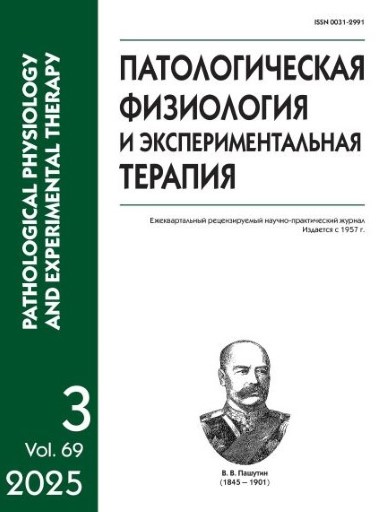A biopotential-mediated approach to studying the effects of a benzimidazole derivative with 5-HT2A antagonist activity and evaluating its antipsychotic effects in the neonatal ventral hippocampal lesion model in rats
Abstract
Introduction. In recent years, the role of the serotonergic system in the pathogenesis of schizophrenia has been extensively studied with a particular focus on 5-HT2A receptors as pharmacological targets.
The aim of the study was to evaluate the antipsychotic activity of the novel benzimidazole derivative, RU-31, with a 5-HT2A antagonist activity by analysis of brain bioelectrical activity and behavioral tests in a rat model of psychosis induced by neonatal ventral hippocampal lesions.
Methods. Rats (250-290 g) were implanted with electrodes to record the bioelectrical activity of the brain. Data were processed using a convolutional autoencoder, and the UMAP algorithm, and distances between signal clusters in the parametric space were calculated. Changes in the brain activity after the administration of RU-31 were compared with reference drugs (chlorpromazine, haloperidol, clozapine, risperidone, quetiapine, amitriptyline, fluoxetine, paroxetine, escitalopram, ketanserin, cyproheptadine, hydroxyzine, sumatriptan, ondansetron, atropine, suprastin). Psychosis was modeled in rats by bilateral injection of ibotenic acid (1.5 μg) into the ventral hippocampus on postnatal day 7. The following groups were formed: control (saline 10 ml/kg); RU-31 (10 mg/kg); clozapine (7,5 mg/kg), and sham-operated animals. The groups were then evaluated using the open field test, social interaction test, and novel object recognition test.
Results. Analysis of the brain bioelectrical activity showed that RU-31 had a high degree of similarity to both clozapine (similarity coefficient 0.764) and ketanserin (similarity coefficient 0.756). In the open field test, rats with ibotenic acid-induced lesions displayed hyperlocomotion (Me = 98 crossings, IQR = 50, p<0.01). Administration of RU-31 significantly reduced hyperlocomotion (Me = 58, IQR = 38.75, p<0.05), with a comparable effect observed for clozapine (Me = 47, IQR = 40, p < 0.01). In the social interaction test, RU-31 significantly increased the active behavior duration (Me = 227.6 s, IQR = 59.5, p<0.05), whereas clozapine did not induce a statistically significant effect (Me = 152.8, IQR = 91.4, p>0.05). In the novel object recognition test, RU-31 and clozapine enhanced the discrimination index in the long-term retention phase (Me=0.73, IQR=0.34, and Me=0.68, IQR=0.32, p<0.05, respectively).
Conclusion. The findings confirm the antipsychotic potential of RU-31, particularly in addressing negative and cognitive symptoms, suggesting its promise as a candidate for treating refractory psychotic disorders.
Downloads
References
2. Mosolov S.N., Yaltonskaya P.A. Primary and Secondary Negative Symptoms in Schizophrenia. Front Psychiatry. 2022; 12: 766692. https://doi.org/10.3389/fpsyt.2021.766692
3. Correll C.U., Schooler N.R. Negative Symptoms in Schizophrenia: A Review and Clinical Guide for Recognition, Assessment, and Treatment. Neuropsychiatr Dis Treat. 2020; 16: 519-534. https://doi.org/10.2147/ndt.s225643
4. Quednow B.B., Geyer M.A., Halberstadt A.L. Serotonin and schizophrenia. In Müller C.P., Jacobs B.L. (Eds.). Handbook of the behavioral neurobiology of serotonin. Elsevier Academic Press. 2010; 585-620. https://doi.org/10.1016/S1569-7339(10)70102-8
5. Kantrowitz J.T. Targeting Serotonin 5-HT2A Receptors to Better Treat Schizophrenia: Rationale and Current Approaches. CNS Drugs. 2020; 34(9): 947-959. https://doi.org/10.1007/s40263-020-00752-2
6. Sysoev Y.I., Okovityi S.V. Prospects of Electrocorticography in Neuropharmacological Studies in Small Laboratory Animals. Brain Sci. 2024; 14(8): 772. https://doi.org/10.3390/brainsci14080772
7. Kalitin K.Y., Nevzorov A.A., Spasov A.A., Mukha O.Y. Deep learning analysis of intracranial EEG for recognizing drug effects and mechanisms of action. Computer Research and Modeling. 2024; 16(3): 755-772. https://doi.org/10.20537/2076-7633-2024-16-3-755-772
8. Kalitin K.Y., Spasov A.A., Mukha O.Y. Developmental and lesion models of schizophrenia in rodents. Journal of Volgograd State Medical University. 2024; 20(4): 28-36. https://doi.org/10.19163/1994-9480-2023-20-4-28-36
9. Guskova T.A. Preclinical toxicological study of drugs as a guarantee of their safe clinical investigations, Toxicol. Rev. 2010; 5: 2-5
10. McInnes L., Healy J., Melville J. UMAP: Uniform Manifold Approximation and Projection. Journal of Open Source Software. 2018; 3(29): 861. https://doi.org/10.21105/joss.00861
11. Holze F., Madsen M.K., Svarer C., Gillings N., Stenbaek D.S., Rudin D., Duthaler U., Liechti M.E., Fisher P.M., Knudsen G.M. Ketanserin exhibits dose- and concentration-proportional serotonin 2A receptor occupancy in healthy individuals: Relevance for psychedelic research. Eur Neuropsychopharmacol. 2024; 88: 43-48. https://doi.org/10.1016/j.euroneuro.2024.07.003
12. Jacobs E.T., Akers K.G., Vohra V., King A.M. Cyproheptadine for Serotonin Toxicity: an Updated Systematic Review and Grading of Evidence. Curr Emerg Hosp Med Rep. 2020; 8: 151-159. https://doi.org/10.1007/s40138-020-00222-5
13. de Bartolomeis A., Vellucci L., Barone A., Manchia M., De Luca V., Iasevoli F., Correll C.U. Clozapine's multiple cellular mechanisms: What do we know after more than fifty years? A systematic review and critical assessment of translational mechanisms relevant for innovative strategies in treatment-resistant schizophrenia. Pharmacol Ther. 2022; 236: 108236. https://doi.org/10.1016/j.pharmthera.2022.108236
14. Ouhaz Z., Ba-M'hamed S., Bennis M. Haloperidol treatment at pre-exposure phase reduces the disturbance of latent inhibition in rats with neonatal ventral hippocampus lesions. C R Biol. 2014; 337(10): 561-570. https://doi.org/10.1016/j.crvi.2014.07.005
15. Feifel D., Shilling P.D. Modeling Schizophrenia in Animals. In Conn P.M. (Ed.). Animal Models for the Study of Human Disease. 2nd. ed. [s.l.] Elsevier. 2017; 587-617. https://doi.org/10.1016/B978-0-12-809468-6.00023-1
16. Căpățînă O.O., Micluția I.V., Fadgyas-Stănculete M. Current perspectives in treating negative symptoms of schizophrenia: A narrative review (Review). Exp Ther Med. 2021; 21(3): 276. https://doi.org/10.3892/etm.2021.9707
17. Becker A., Grecksch G. Haloperidol and clozapine affect social behaviour in rats postnatally lesioned in the ventral hippocampus. Pharmacol Biochem Behav. 2003; 76(1): 1-8. https://doi.org/10.1016/s0091-3057(03)00139-4
18. Rueter L.E., Ballard M.E., Gallagher K.B., Basso A.M., Curzon P., Kohlhaas K.L. Chronic low dose risperidone and clozapine alleviate positive but not negative symptoms in the rat neonatal ventral hippocampal lesion model of schizophrenia. Psychopharmacology (Berl). 2004; 176(3-4): 312-319. https://doi.org/10.1007/s00213-004-1897-4
19. Apam-Castillejos D.J., Tendilla-Beltrán H., Vázquez-Roque R.A., Vázquez-Hernández A.J., Fuentes-Medel E., García-Dolores F., Díaz A., Flores G. Second-generation antipsychotic olanzapine attenuates behavioral and prefrontal cortex synaptic plasticity deficits in a neurodevelopmental schizophrenia-related rat model. J Chem Neuroanat. 2022; 125: 102166. https://doi.org/10.1016/j.jchemneu.2022.102166
20. Tendilla-Beltrán H., Garcés-Ramírez L., Martínez-Vásquez E., Nakakawa A., Gómez-Villalobos M.J., Flores G. Differential Effects of Neonatal Ventral Hippocampus Lesion on Behavior and Corticolimbic Plasticity in Wistar-Kyoto and Spontaneously Hypertensive Rats. Neurochem Res. 2024; 49(4): 959-979. https://doi.org/10.1007/s11064-023-04074-9






